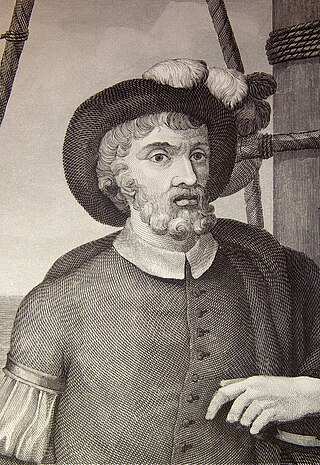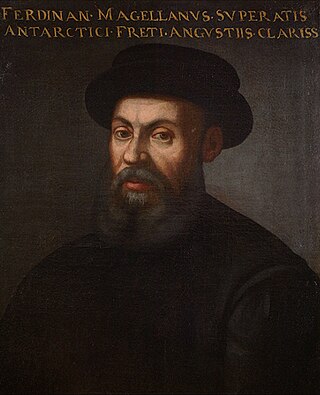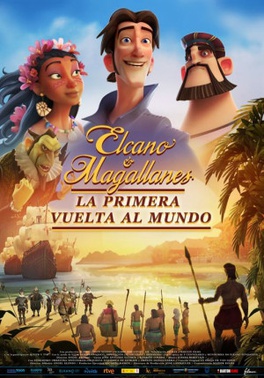
Circumnavigation is the complete navigation around an entire island, continent, or astronomical body. This article focuses on the circumnavigation of Earth.

The Battle of Mactan was a battle fought on a beach in Mactan Island between the Spanish forces led by the Portuguese explorer Ferdinand Magellan along with local allies, and Lapulapu, the chieftain of the island, on the early morning hours of April 27, 1521. Magellan, a Portuguese-born commander serving the Spanish Empire who led an expedition that ultimately circumnavigated the world for the first time, commanded a small Spanish contingent in an effort to subdue Mactan led by Lapulapu under the Spanish crown. The sheer number of Lapulapu's forces, compounded with issues on the location and armor, ultimately resulted in a disastrous defeat to the Europeans and the death of Magellan. Surviving members of Magellan's crew continued the expedition under the command of Juan Sebastian de Elcano, who completed the journey in September 1522.

Juan Sebastián Elcano was a Spanish navigator, ship-owner and explorer of Basque origin from Getaria, part of the Crown of Castile when he was born, best known for having completed the first circumnavigation of the Earth in the Spanish ship Victoria on the Magellan expedition to the Spice Islands. He received recognition for his achievement by Charles I of Spain with a coat of arms bearing a globe and the Latin motto Primus circumdedisti me.

The Strait of Magellan, also called the Straits of Magellan, is a navigable sea route in southern Chile separating mainland South America to the north and Tierra del Fuego to the south. The strait is considered the most important natural passage between the Atlantic and Pacific oceans. It was navigated by canoe-faring indigenous peoples including the Kawésqar for thousands of years. The strait is approximately 570 km long and 2 km wide at its narrowest point. In 1520, the Spanish expedition of Ferdinand Magellan, after whom the strait is named, became the first Europeans to discover it.

Enrique of Malacca, was a Malay member of the Magellan expedition that completed the first circumnavigation of the world in 1519–1522. He was acquired as a slave by the Portuguese explorer Ferdinand Magellan in 1511 at the age of 14 years, probably in the early stages of the capture of Malacca. Although Magellan's will calls him "a native of Malacca", Antonio Pigafetta states that he was a native of Sumatra. Magellan later took him to Europe, where he accompanied the circumnavigation expedition in 1519. According to some historians, it is possible that he could be the first person to circumnavigate the globe and return to his starting point, however, there is no record or source that confirms it.

Antonio Pigafetta was a Venetian scholar and explorer. He joined the Spanish expedition to the Spice Islands led by Portuguese explorer Ferdinand Magellan, the world's first circumnavigation, and is best known for being the chronicler of the voyage. During the expedition, he served as Magellan's assistant until Magellan's death in the Philippine Islands, and kept an accurate journal, which later assisted him in translating the Cebuano language. It is the first recorded document concerning the language.

Victoria or Nao Victoria was a carrack famed as the first ship to successfully circumnavigate the world. Victoria was part of the Spanish expedition to the Moluccas commanded by the explorer Ferdinand Magellan.
Minoru Saitō(斉藤 実, born January 7, 1934) is a Japanese solo yachtsman and one of the most notable veteran ocean sailboat racers in the world. He became the oldest person at age 77 to do a solo circumnavigation of the globe. He has successfully made eight solo circumnavigations.

NOAAS Oceanographer, originally USC&GS Oceanographer, was an American Oceanographer-class oceanographic research vessel in service in the United States Coast and Geodetic Survey from 1966 to 1970 and in the National Oceanic and Atmospheric Administration (NOAA) from 1970 to 1996. She served as flagship of both the Coast and Geodetic Survey and NOAA fleets.
Cristóbal de Haro was a Castilian financier and merchant from Burgos, famous for having provided funding for the Magellan-Elcano expedition.

João Rodrigues Serrão, also known as Juan Rodríguez Serrano, was a Portuguese and Spanish pilot and explorer. He served in the Portuguese India Armadas that secured control of the Indian Ocean and the Strait of Malacca for the Portuguese but is most well known for his participation in Ferdinand Magellan's 1519–1521 expedition to the Spice Islands for Charles I of Spain, which discovered a path around South America to the Pacific and initiated Spanish involvement in the Philippines. Serrão and Duarte Barbosa became leaders of the expedition after Magellan's death at the Battle of Mactan but did not live to complete the circumnavigation with Elcano. They were both killed shortly thereafter during a massacre of the Spanish by their supposed convert and ally Humabon, raja of Cebu.

The Magellan-Elcano expedition was a 16th-century Spanish expedition planned and led by Portuguese explorer Ferdinand Magellan with the objective of opening a trade route with the Moluccas. The expedition departed from Spain in 1519, and was completed in 1522 by Spanish navigator Juan Sebastián Elcano after Magellan's death, crossing the Atlantic, Pacific, and Indian oceans, culminating in the first circumnavigation of the world.
Charles Hector Jacquinot was a noted mariner, best known for his role in early French Antarctic surveys.

Ferdinand Magellan ( mə-GHEL-ən or mə-JEL-ən; Portuguese: Fernão de Magalhães, IPA:[fɨɾˈnɐ̃w̃dɨmɐɡɐˈʎɐ̃j̃ʃ]; Spanish: Fernando de Magallanes, IPA:[feɾˈnandoðemaɣaˈjanes]; was a Portuguese explorer best known for having planned and led the 1519 Spanish expedition to the East Indies across the Pacific Ocean to open a maritime trade route, during which he discovered the interoceanic passage thereafter bearing his name and achieved the first European navigation to Asia via the Pacific.

Laurence Bergreen is an American historian and author.

Operation Sandblast was the code name for the first submerged circumnavigation of the world, executed by the United States Navy nuclear-powered radar picket submarine USS Triton (SSRN-586) in 1960 under the command of Captain Edward L. Beach Jr.

The Magellan expedition was the first voyage around the world in human history. It was a Spanish expedition that sailed from Seville in 1519 under the initial command of Ferdinand Magellan, a Portuguese sailor, and completed in 1522 by Spanish Basque navigator Juan Sebastián Elcano.
Gaspar de Quesada was a Spanish explorer who participated in Magellan's circumnavigation as captain of the Concepción, one of the expedition's five ships. Approximately six months in to the expedition, Quesada, with two other Spanish captains, attempted to overthrow Magellan in the Easter mutiny at the South American port of St. Julian. The mutiny failed and Magellan had Quesada executed.

Elcano & Magellan: The First Voyage Around the World is a 2019 Spanish animated adventure film directed by Ángel Alonso and written by José Antonio Vitoria and Garbiñe Losana. The film retells the story of 1519 circumnavigation led by Portuguese explorer Ferdinand Magellan and Spanish navigator Juan Sebastián Elcano.














